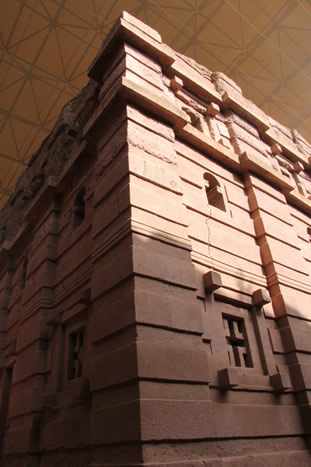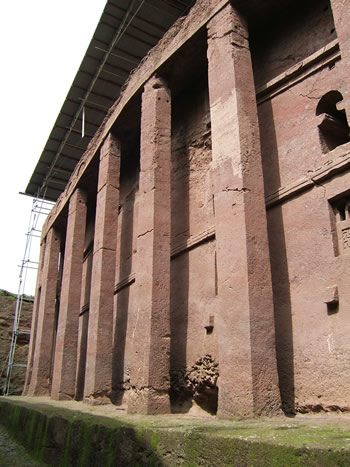Lalibela Rock-Hewn Churches
Lalibela is a town in Amhara Region, northern Ethiopia famous for monolithic rock-cut churches. The whole of Lalibela offers an exceptional testimony to the medieval and post-medieval civilization of Ethiopia. Lalibela is one of Ethiopia's holiest cities, second only to Aksum, and a center of pilgrimage. Unlike Aksum, the population of Lalibela is almost completely Ethiopian Orthodox Christian. Ethiopia is one of the earliest nations to adopt Christianity in the first half of the fourth century, and its historical roots date to the time of the Apostles. The churches themselves date from the seventh to thirteenth centuries, and are traditionally dated to the reign of the Zagwe dynasty king Gebre Mesqel Lalibela (r. ca. 1181–1221 AD).
The layout and names of the major buildings in Lalibela are widely accepted, especially by local clergy, to be a symbolic representation of Jerusalem. This has led some experts to date the current church forms to the years following the capture of Jerusalem in 1187 by Muslim leader, Saladin.
Lalibela is located in the Semien Wollo Zone of the Amhara Region, at roughly 2,500 meters above sea level. It is the main town in Lasta woreda, which was formerly part of Bugna woreda. The Rock-Hewn Churches were declared a UNESCO World Heritage Site in 1978.
Churches
 This rural town is known around the world for its churches carved from within the earth from "living rock," which play an important part in the history of rock-cut architecture. Though the dating of the churches is not well established, most are thought to have been built during the reign of Lalibela, namely during the 12th and 13th centuries. Unesco identifies 11 churches, assembled in four groups:
This rural town is known around the world for its churches carved from within the earth from "living rock," which play an important part in the history of rock-cut architecture. Though the dating of the churches is not well established, most are thought to have been built during the reign of Lalibela, namely during the 12th and 13th centuries. Unesco identifies 11 churches, assembled in four groups:
The Northern Group:
- Biete Medhane Alem (House of the Saviour of the World), home to the Lalibela Cross.
- Biete Maryam (House of Miriam/House of Mary), possibly the oldest of the churches, and a replica of the Tombs of Adam and Christ.
- Biete Golgotha Mikael (House of Golgotha Mikael), known for its arts and said to contain the tomb of King Lalibela)
- Biete Meskel (House of the Cross)
- Biete Denagel (House of Virgins)
The Western Group:
- Biete Giyorgis (Church of Saint George), thought to be the most finely executed and best preserved church
The Eastern Group:
- Biete Amanuel (House of Emmanuel), possibly the former royal chapel
- Biete Qeddus Mercoreus (House of St Mercoreos/House of St Mark), which may be a former prison
- Biete Abba Libanos (House of Abbot Libanos)
- Biete Gabriel-Rufael (House of the angels Gabriel, and Raphael) possibly a former royal palace, linked to a holy bakery.
- Biete Lehem (Bethlehem Hebrew: בֵּית לֶחֶם, House of Holy Bread).
Farther afield, lie the monastery of Ashetan Maryam and Yimrehane Kristos Church, (possibly eleventh century, built in the Aksumite fashion, but within a cave).
 There is some controversy as to when some of the churches were constructed. David Buxton established the generally accepted chronology, noting that "two of them follow, with great fidelity of detail, the tradition represented by Debra Damo as modified at Yemrahana Kristos." Since the time spent to carve these structures from the living rock must have taken longer than the few decades of King Lalibela's reign, Buxton assumes that the work extended into the 14th century. However, David Phillipson, professor of African archeology at Cambridge University, has proposed that the churches of Merkorios, Gabriel-Rufael, and Danagel were initially carved out of the rock half a millennium earlier, as fortifications or other palace structures in the waning days of the Axumite Kingdom, and that Lalibela's name simply came to be associated with them after his death. On the other hand, local historian Getachew Mekonnen credits Masqal Kibra, Lalibela's queen, with having one of the rock-hewn churches (Abba Libanos) built as a memorial for her husband after his death.
There is some controversy as to when some of the churches were constructed. David Buxton established the generally accepted chronology, noting that "two of them follow, with great fidelity of detail, the tradition represented by Debra Damo as modified at Yemrahana Kristos." Since the time spent to carve these structures from the living rock must have taken longer than the few decades of King Lalibela's reign, Buxton assumes that the work extended into the 14th century. However, David Phillipson, professor of African archeology at Cambridge University, has proposed that the churches of Merkorios, Gabriel-Rufael, and Danagel were initially carved out of the rock half a millennium earlier, as fortifications or other palace structures in the waning days of the Axumite Kingdom, and that Lalibela's name simply came to be associated with them after his death. On the other hand, local historian Getachew Mekonnen credits Masqal Kibra, Lalibela's queen, with having one of the rock-hewn churches (Abba Libanos) built as a memorial for her husband after his death.
Contrary to the alternative theories created and advocated by Alternative Archaeologist writers like Graham Hancock, Buxton states the great rock-hewn churches of Lalibela were not built with the help of the Knights Templar; asserting abundant evidence exists to show that they were produced solely by medieval Ethiopian civilization. For example, while Buxton notes the existence of a tradition that "Abyssinians invoked the aid of foreigners" to construct these monolithic churches, and admits that "there are clearly signs of Coptic influence in some decorative details" (hardly surprising given the theological, ecclesiastical, and cultural links between the Ethiopian Orthodox and Coptic Orthodox Churches), he is adamant about the native origins of these creations: "But the significant fact remains that the rock-churches continue to follow the style of the local built-up prototypes, which themselves retain clear evidence of their basically Axumite origin."
The churches are also a significant engineering feat, given that they are all associated with water (which fills the wells next to many of the churches), exploiting an artesian geological system that brings the water up to the top of the mountain ridge on which the city rests.
Video
Megalithic Builders is an index of ancient sites from around the world that contain stone megaliths or interlocking stones. Genus Dental Sacramento

